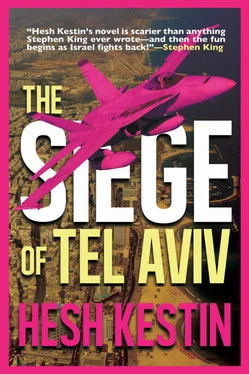Misha rises. “That’s me.”
One of his crew shakes his head. “Misha, it’s just a drill.”
“At 4 a.m.? They don’t do drills when everyone is sleeping.”
As the news reader continues to read code names for IDF units, a siren goes off.
“Ladies, go to your units.” Deftly, almost magically, a knife replaces the gun in Misha’s hand. He approaches the man tied in the chair. “Alon Peri, you too,” he says as he slices through the ropes. “Looks like we’re partners after all.”
DETERMINED TO AVOID THE central strategic miscalculation of what the Jews call the Yom Kippur War and the Arabs call the Ramadan War, the planners in Iran early on discovered they must choose from two modes of attack. In 1973, the armies of Egypt, Syria, and Iraq, together with contingents from Saudi Arabia, Kuwait, Libya, Algeria, Tunisia, Pakistan, Sudan, Cuba, and North Korea, converged on Israel on the holiest day of the Jewish year, when all shops, offices, and businesses were closed, most of the population was fasting at home or in the synagogue, the country’s well-organized bus system closed down, its trains sat in their marshaling yards and no vehicular traffic was on the roadways. On this day even Israeli Arabs made sure not to drive, at least not through Jewish neighborhoods. The IDF whittled itself down to a skeleton force as soldiers and reservists found their way to a day of fasting, prayer and reflection at home.
On any other day, the reservists who make up the bulk of Israel’s armed forces would have been scattered and the roads so congested with traffic it would have taken hours for pilots to reach their planes, tank crews their tanks, sailors their vessels. Israel’s telephone system would already have been at peak capacity. The extra usage as parents called their children, as officers and enlisted personnel called their units, would have turned the national communications grid into one long busy signal.
Instead, when the sirens went off on Yom Kippur, there was not a man, woman, or child in Israel who thought it might be a drill. Phone calls were put through immediately. Reservists drove on near-deserted roads at one hundred miles an hour to reach their bases. Tanks and military vehicles used the same wide-open roads to meet the enemy attack and hold it until the reserves arrived to back them up. Were it not for the strategic blunder of an attack on the least effective day of the year, Israel might well have been destroyed in 1973.
General Niroomad’s planners spent months dissecting that day. They concluded that only two modes of approach were possible: a daylight attack that would have the Israel war machine tied up in traffic jams, or a nighttime attack benefiting from surprise. In the end the element of surprise, supported by fifth columnists to neutralize the Israel Air Force, won out. But the Iranians knew a night attack would find resistance from the Muslim armies: by tradition or preference or just fear of the dark, Arabs had never favored fighting at night. Even T.E. Lawrence could not convince his faithful Bedouins to attack before dawn.
Recognizing this lapse, during the British Mandate an officer in His Majesty’s forces sympathetic to the Jewish cause organized the first Jewish commando since the days of the Maccabees. Major Orde Wingate knew what he was doing when he called his outfit the Special Night Squads. In Israel’s War of Independence, IDF units became adept at taking back during the night what had been lost to overwhelming Arab forces during the day. But now the Iranians had a solution: the starlight scope, which sucks in available ambient light from even a moonless night and concentrates it to create a ghostly green-tinged image of what cannot be seen with the naked eye.
Armed with the SLS, not only Arab officers but entire units could proceed as though in daylight. SLS devices could be mounted in Egyptian, Iraqi, Syrian, and Jordanian tanks, on sniper rifles, on mobile artillery, even on trucks and armored personnel carriers. The question was: where could these instruments be obtained in massive numbers?
Though the West maintains constant satellite surveillance of the arms factories of the People’s Republic of China, no Western nation bothers monitoring the center of optics manufacture at Wuhan in Hubei Province—who cares if the Chinese are suddenly a good deal more myopic? In return for the usual guarantees of access to Middle East oil, China provided Iran, and through Iran the Arab armies, with a secret weapon that was hardly secret. SLS devices had been part of every armed conflict since the Vietnam War, but they had never been used strategically.
Now the Arabs are no longer afraid of the dark. What does it matter if the IDF is better trained, better organized, and more intensely motivated than any fighting force in history? Compared to his enemy, the Israeli soldier is blind.
THIS DISADVANTAGE IS NOT known to the IDF command as 200,000 Israelis, men and women up to the age of fifty-five, fathers and sons and mothers and daughters, are called to duty. There is no warning: the sirens go off in the cities at the same time as the population hears, sees, and feels the sound and fury of a military attack already in progress.
The primary target is Jerusalem, the seat of Israel’s government, where the first assault is from the air. A second wave of bombing very quickly arrives at Haifa and Beersheba, the country’s third and fourth most populous cities. Aside from carefully chosen targets—the IDF’s headquarters at the Kirya, the Mossad’s operations center in the northern suburbs, and the municipality building on Ibn-Gvirol Street—Tel Aviv is studiously ignored.
Because it is barely touched by aerial attack and has no tanks and infantry at its gates, Israel’s first city responds by the book. Municipal buses make for designated staging areas where they will be filled with reservists to be delivered to their bases, from which they will move as units to the front; police are issued automatic weapons and take to the streets directing headlong traffic traveling without headlights on roads whose lighting is snuffed out; doctors and nurses not in the reserves make for emergency rooms at nearby hospitals, where generators are readied and marginal patients are sent home to make room for a flood of wounded; gas stations are reopened in the middle of the night; the population is warned via television, radio, and loudspeaker to enter the shelters below every apartment house or the hardened concrete rooms in every private residence, to black out all windows, and to make sure that everyone remembers to have his gas mask within reach.
While the rest of the country reels in confusion and shock, Tel Aviv is awake and responsive.
Right off the beach promenade at the gay nightclub called Ema, the strobe lights continue turning above the abandoned dance floor, drinks stand unfinished on tables, high-decibel recorded music pounds a room empty but for the odd cigarette burning down in an ashtray.
At the nearby marina, the fifty-two-foot Hatteras bobs peacefully at its mooring at the end of a long dock, its lights out, television silent. Boats of all kinds remain tied up, except for a few powerful vessels owned by visiting yachtsmen, who decide to take their chances on the seaway to Cyprus, 230 miles distant.
And in a villa in Herzlia Pituach, seven miles up the coast, a forty-six-year-old industrialist ceases making love to the wife whose passion for him has reignited now that their son is out of the house. As the sirens go off, Yigal Lev reaches for the television remote, sees the face of a somber newscaster before an image of the national flag, and moves immediately to pull his uniform from its special place in the closet. As he straps on his sidearm, he hears his wife whisper their son’s name.
Читать дальше












